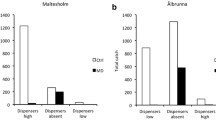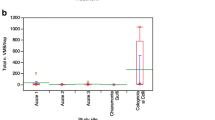Abstract
Mating disruption of the carpenter moth, Cossus insularis (Staudinger) (Lepidoptera: Cossidae), with a synthetic version of its sex pheromone, a mixture of (E)-3-tetradecenyl acetate and (Z)-3-tetradecenyl acetate, was tested for three successive years in apple (Malus domestica Borkh.) orchards. Pheromone trap catches, percentage mating of tethered females and females enclosed with males in a mating cage, and tree damage were measured in both the pheromone-treated and untreated control orchards. The attraction of male moths to pheromone traps at heights of 1.5, 3, and 5 m was strongly disrupted when the pheromone dispensers were placed at 1.5 m height. Mating of tethered females placed at 1 m was completely inhibited, and the mating of tethered females at a height of 3 m was significantly reduced by the treatment in comparison to matings in an untreated control orchard. Similarly, mating of pairs of moths enclosed in mating cages was significantly reduced by the synthetic pheromone treatment in comparison to controls. The percentage of damaged trees in the pheromone-treated orchard also decreased significantly over the course of the experiment. These results suggest that mating disruption with the synthetic sex pheromone appears promising for reducing damage caused by C. insularis in apple orchards in Japan, and a commercial mating disruption product has been developed and registered.



Similar content being viewed by others
References
Aono N, Natsumi K, Yukawa Y (1989) Mating suppression to the cherry tree borer, Synanthedon hector Butler, in Japanese apricot by its synthetic sex pheromone. Plant Prot 43:329–332 (in Japanese)
Cardé RT, Minks AK (1995) Control of moth pests by mating disruption: Successes and constraints. Annu Rev Entomol 40:559–585
Chen X, Nakamuta K, Nakanishi T, Nakashima T, Tokoro M, Mochizuki F, Fukumoto T (2006) Female sex pheromone of a carpenter moth, Cossus insularis (Lepidoptera: Cossidae). J Chem Ecol 32:669–679
Escofet M, Boada J, Melo JC, Casals C, Barrios G, Palau G, Cavallé C, Pelaez M, Mateu J, Aymami A, Nubiola N, Ribé E, Ibáñez R, Santiveri C, Sans J, Pallarés J, Agustí JA (2005) Sexual disruption to control leopard moth (Zeuzera pyrina) in hazelnut. Acta Hortic 686:421–425
European Commission (2009) Legislation on Plant Protection Products, http://ec.europa.eu/food/plant/pesticides/legislation/index_en.htm, Accessed 20 June, 2016
Gökçe A, Stelinski LL, Gut LJ, Whalon ME (2007) Comparative behavioral and EAG responses of female obliquebanded and redbanded leafroller moths (Lepidoptera: Tortricidae) to their sex pheromone components. Eur J Entomol 104:187–194
Hegazi, EM, Khafagi WE, Konstantopoulou MA, Schlyter F, Raptopoulos D, Shweil S, Abd El-Rahman S, Atwa A, Tawfik H (2010) Suppression of leopard moth (Lepidoptera: Cossidae) populations in olive trees in Egypt through mating disruption. J Econ Entomol 103:1621–1627
Japanese Society of Applied Entomology and Zoology (2006) Major insect and other pests of economic plants in Japan, Revised edition. Japan Plant Protection Association, Tokyo, Japan, p. 387 (in Japanese)
Kitajima H, Makihara H, Hasegawa M (1998) Morphology and injury forms of larvae of Cossus spp. (Lepidoptera: Cossidae). Trans Kanto Br Jpn For Soc 49:65–68 (in Japanese)
Matsumoto K, Nakamuta K, Nakashima T (2007) Mating disruption controls the cherry tree borer, Synanthedon hector (Butler) (Lepidoptera: Sesiidae), in a steep orchard of cherry trees. J For Res 12:34–37
Minamishima M, Arakawa A, Okazaki K, Mochizuki F, Fukumoto T (2004) An easy method for estimating the efficacy of mating disruption in the oriental fruit moth, Grapholita molesta (Busck) (Lepidoptera: Tortricidae). Jpn J Appl Entomol Zool 48:201–205 (in Japanese)
Nakamuta K, Chen X, Kitajima H, Nakanishi T, Yoshimatsu S (2007) Ecology of three species of Cossus carpenter moths in Japan. For Pests 56:5–9 (in Japanese)
Nakamuta K, Itou S, Sasaki M, Nakanishi T, Minamishima M (2010) The carpenter moth, Cossus insularis, as an insect pest of the apple and Japanese pear trees in Japan. Plant Prot 64:779–781 (in Japanese)
Nakanishi, T (2005) First report of occurrence of Cossus insularis (Staudinger) on the Japanese pear. Jpn J Appl Entomol Zool 49:23–26 (in Japanese with an English summary)
Nakanishi T, Nakamuta K, Mochizuki F, Fukumoto T (2013) Mating disruption of the carpenter moth, Cossus insularis (Staudinger) (Lepidoptera: Cossidae) with synthetic sex pheromone in Japanese pear orchards. J Asia-Pacific Entomol 16:251–255
Natale D, Pasqualini E (1999) Il controllo di zeuzera e cossus mediante feromoni. Inf Agrar 16:79–83
Tadauchi O, Inoue H (2000) On MOKUROKU file based on “A Check List of Japanese Insects” on INTERNET. Esakia: Occasional papers of the Hikosan Biological Laboratory in Entomology, 40, pp.81–84, http://www.konchudb.agr.agr.kyushu-u.ac.jp/mokuroku/exec/, Accessed 20 June, 2016.
USEPA (2009) Straight Chain Lepidopteran Pheromones, https://www3.epa.gov/pesticides/chem_search/reg_actions/registration/decision_PC-000004_27-Feb-09.pdf, Accessed 20 June, 2016.
Witzgall P, Kirsch P, Cork A (2010) Sex pheromones and their impact on pest management. J Chem Ecol 36:80–100
Yaginuma K (1984) Cherry tree borer. Experimental method of pheromones, vol. 2. Japan Plant Protection Association, Tokyo, pp. 116–120 (in Japanese)
Yang MW, Dong SL, Chen L (2009) Electrophysiological and behavioral responses of female beet armyworm Spodoptera exigua (Hübner) to the conspecific female sex pheromone. J Insect Behav 22:153–164
Acknowledgments
We thank Takehiko Fukumoto and Fumiaki Mochizuki of Shin-Etsu Chemical Co., Ltd. for their invaluable comments on the manuscript, and Masayuki Hayashi of Chiba University for his suggestions on the statistical analyses. This study was supported by Science and Technology Research Promotion Program for Agriculture, Forestry, Fisheries and Food Industry (Project # 23060) from 2011 to 2013.
Author information
Authors and Affiliations
Corresponding author
Rights and permissions
About this article
Cite this article
Hoshi, H., Takabe, M. & Nakamuta, K. Mating Disruption of a Carpenter Moth, Cossus insularis (Lepidoptera: Cossidae) in Apple Orchards with Synthetic Sex Pheromone, and Registration of the Pheromone as an Agrochemical. J Chem Ecol 42, 606–611 (2016). https://doi.org/10.1007/s10886-016-0723-x
Received:
Revised:
Accepted:
Published:
Issue Date:
DOI: https://doi.org/10.1007/s10886-016-0723-x




